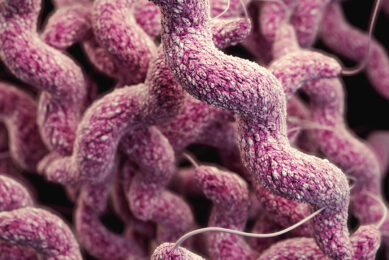Research: Biofilm production aids Campylobacter survival
Scientists at the Institute of Food Research in the UK have found a way that the foodborne pathogen Campylobacter can survive in the environment.
Campylobacter is the main cause of food poisoning in Europe and America, most often contracted from eating under-cooked chicken or turkey. It is estimated that there are more than 400,000 cases of Campylobacter food poisoning annually in the UK alone, costing the UK economy an estimated £500 mln each year.
Campylobacter cannot survive in the oxygen levels in the air, which forces the bacterium to adapt for survival in the food chain. One such a survival strategy is to form a biofilm, whereby the bacteria stick to a surface and encase themselves in a sticky ‘slime’ that protects them.
In research published in the journal Applied and Environmental Microbiology, IFR researchers have found that Campylobacter will readily form a biofilm under laboratory conditions and that when the bacteria were left in air, they respond to these stressful conditions by more rapidly forming this biofilm.
Campylobacter cells were also shed from the biofilm under environmental conditions, showing that a biofilm is a reservoir of cells that can subsequently enter the food chain, potentially leading to instances of food poisoning.
“Campylobacter can clearly sense their stressful environment and try to protect themselves by making a biofilm. Now we need to focus in on those systems that actual sense the stress, in particular, the oxygen sensors,” commented Dr. Mark Reuter.
“While biofilms are well established in the lifestyle and success of other pathogenic bacteria, their role in the lifestyle of Campylobacter was still unclear. We now have developed a model where the biofilm plays a central role in the transmission of Campylobacter via the food chain, and this may lead to new antimicrobial approaches, like disrupting the biofilm matrix or prevention of biofilm formation,” said Dr. Arnoud van Vliet.
By understanding how Campylobacter survives in the environment, this research may suggest novel ways that the food industry can eliminate these bacteria from the food chain or prevent them from entering it at all.
The Institute of Food Research is an institute of the Biotechnology and Biological Sciences Research Council (BBSRC). This research was funded by the BBSRC.













